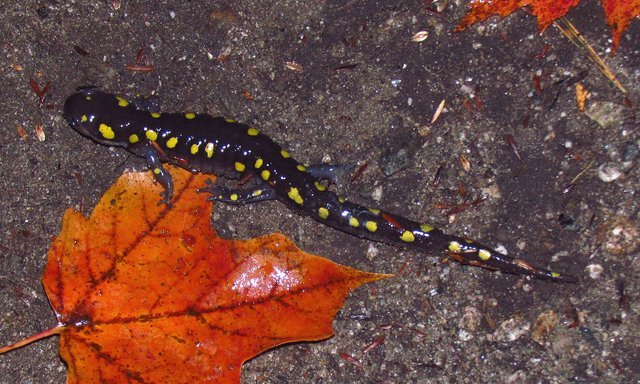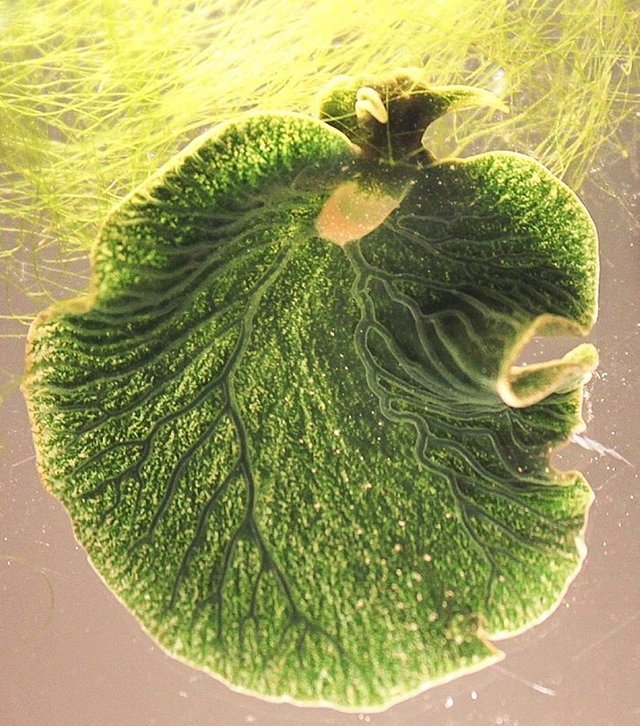It's no secret that in the process of evolution green plants, algae and some bacteria have 'learned' to use the energy of the sunlight to produce glucose. To do that they only need water (H2O) and CO2. The energy from the sun is absorbed by the pigment chlorophyll and then used to build the molecules ATP and NADPH/H+ which later deliver the energy to build glucose (6 H2O + 6 CO2 ---> C6H12O6 + 6 O2).
Are animals able to do that as well? Not really ... But amazingly several kinds of animals eat algae without to digest them. As a consequence these algae survive, get into the cells of the animals, keep doing photosynthesis and produce glucose and oxygen.
The 'solar salamander'

By D. Gordon E. Robertson - Own work, CC BY-SA 3.0, https://commons.wikimedia.org/w/index.php?curid=29009376
Even vertebrates can have these skills: It was already well known before that embryos in the eggs of the salamander Ambystoma maculatum develop slower if there are not enough algae (Oophila amblystomatis) in their surrounding jelly.[1] At first scientists concluded that there should be a kind of symbiosis whereby the embryos of the salamander profited from the produced oxygen of the algae and the algae could use the nitrogen-rich waste of the embryos. However using the method of transmission electron microscopy Ryan Kerney of Dalhousie University in Halifax found out that other than expected algae lived not only in close proximity of the eggs but actually inside the embryonic cells. Two arising questions come in mind:
- How could the algae come into the embryo?
- Why doesn't the immune system of the embryonic cells attack the algae (which normally happens with 'unknown' material in cells of vertebrates)?
One possible explanation beside others is that symbiotic algae in the oviducts of adult female salamanders could enter the passing germ cells. Also nearly all salamander cells beware a certain degree of pluripotency. That means even specialized cells can still change into other cell types. Therefore salamanders are able to substitute for example lost extremities. This flexibility could allow salamander cells also to 'learn' to accept algae inside themselves in a process of 'self-recognition' which differs from other vertebrates.
Another interesting observation was that within the salamander cells mitochondria were placed around the ingested algae. Mitochondria are the power plants of the cells and obviously profit from the oxygen and the glucose released by the algae.
Sea slugs: the real 'masters of photosynthesis'

By Karen N. Pelletreau et al. - http://journals.plos.org/plosone/article?id=10.1371/journal.pone.0097477, CC BY 4.0, https://commons.wikimedia.org/w/index.php?curid=38619279
If they knew about it, maybe some sea slugs would name the salamanders above as "beginners only". :) While salamander cells incorporate complete algal cells, some slug species like Elysia chlorotica only suck the liquid out of the cells of the algae Vaucheria litorea. Hereby they also 'steal' their chloroplasts which is called kleptoplasty. :) Thus the algal chloroplasts get into the cells of the slugs where they still keep working and doing photosynthesis.[2] Amazingly the lifespan of the chloroplasts within the slugs lasts longer than it does within the algal cells. According to a recent study published in The Biological Bulletin[3] the slugs do not only incorporate the algal chloroplasts but in addition there can actually happen a transfer of nuclear algal genes into the genome of the slugs! These genes code for chloroplast proteins and chlorophyll synthesis and are active within the slugs. At least one of the genes, prk, has also been verified to exist in larval slugs, that means it becomes transmitted into the next generation of slugs. It plays an important role by maintaining the chloroplasts and allowing for carbon fixation.[4] This also helps to understand why the absorbed chloroplasts survive so long within the slugs.
By the way chloroplasts contain their own genes (like mitochondria as well) and their predecessors have been independent organisms. This is explained by the endosymbiotic theory. You can read more about that in one of my other steemit articles.[5]
Will genetic engineering help us one day to do the same like the slugs? To lie on the beach, reading a book and doing some photosynthesis at the same time? Some scientists do believe exactly that ...
Sources:
1.: http://www.nature.com/news/2010/100730/full/news.2010.384.html
2.: http://www.wissenschaft.de/bild-der-woche/-/journal_content/56/12054/1587863
3.: http://www.journals.uchicago.edu/doi/pdfplus/10.1086/BBLv227n3p300
4.: http://io9.gizmodo.com/confirmation-that-photosynthesizing-sea-slugs-steal-gen-1683702602
5.: https://steemit.com/steemstem-competition1/@jaki01/baby-with-three-parents
A very attractive post. Thanks a lot.
Downvoting a post can decrease pending rewards and make it less visible. Common reasons:
Submit
Just out of curiosity: where/how did you find this old article? :)
Downvoting a post can decrease pending rewards and make it less visible. Common reasons:
Submit
It seems he found it, just to upvote himself ... :)
Downvoting a post can decrease pending rewards and make it less visible. Common reasons:
Submit
This post has been ranked within the top 50 most undervalued posts in the first half of Feb 12. We estimate that this post is undervalued by $4.85 as compared to a scenario in which every voter had an equal say.
See the full rankings and details in The Daily Tribune: Feb 12 - Part I. You can also read about some of our methodology, data analysis and technical details in our initial post.
If you are the author and would prefer not to receive these comments, simply reply "Stop" to this comment.
Downvoting a post can decrease pending rewards and make it less visible. Common reasons:
Submit
Very interesting. Thanks for sharing. I have noticed that there is a problem with the speech marks "" - are you using mobile?
Downvoting a post can decrease pending rewards and make it less visible. Common reasons:
Submit
Thanks for reading!
Thanks also for pointing out any problems with formatting! I wonder if it is because I use Linux on all my devices (I don't use mobile phone when writing articles). If I view it here everything looks nice ...
Downvoting a post can decrease pending rewards and make it less visible. Common reasons:
Submit
Might be - not sure about it.
Downvoting a post can decrease pending rewards and make it less visible. Common reasons:
Submit
The problem is that I cannot fix it because on my computer it looks good, so I don't see how any changes affect the layout. I will check it on a windows computer as soon as possible (maybe at work tomorrow ...). Or does the problem appear when you read the article using a mobile phone? Thanks again.
Downvoting a post can decrease pending rewards and make it less visible. Common reasons:
Submit
No it is on windows. Don't stress too much over it though. It is still readable.
Downvoting a post can decrease pending rewards and make it less visible. Common reasons:
Submit
OK. :-)
Downvoting a post can decrease pending rewards and make it less visible. Common reasons:
Submit
Nice work here @jaki01. I didn't know about these animals at all, i am especially surprised by the slug which is gaining the photosynthetic genes into its own genome! Fascinating.
Downvoting a post can decrease pending rewards and make it less visible. Common reasons:
Submit
I am glad to see that you like this article.
Yes, really fascinating, and - as always - there are still many open questions. :)
Maybe we can observe evolution working here (if only our lifespan would be somewhat longer) and one day the chloroplasts will be fixed components of the slug cells like their mitochondria ....? For now there happens a transfer of some nuclear genes from algae to the slugs (and at least one of them is verified to be also transmitted to the next generation of the slugs) which are necessary for the functioning of the chloroplasts, but the young slugs still need to ingest chloroplasts itself ...
Downvoting a post can decrease pending rewards and make it less visible. Common reasons:
Submit
Well structural assembly of the chloroplast likely requires a whole host of proteins and enzymes. So perhaps it would take a longer time to assymylate such a gene locus into its genome.
The mitochondrion was in all likelihood an actual organism, rather than just an organelle like the chloroplast. So this (chloroplast production) would seemingly be a more difficult task.
Downvoting a post can decrease pending rewards and make it less visible. Common reasons:
Submit
Also chloroplasts have own genes and should have been independent organisms like mitochondria long time ago. It is assumed that they have been endosymbiotic cyanobacteria.
Downvoting a post can decrease pending rewards and make it less visible. Common reasons:
Submit
Thats right! I forgot about that! Will be interesting to see what happens with these animals, though evolution is slow so perhaps we will not get to know in our lifetimes.
Downvoting a post can decrease pending rewards and make it less visible. Common reasons:
Submit
But I should add that indeed you could be right and it may be a difficult task as most of the proteins in the chloroplasts are not coded anymore in their own genomes ...
Downvoting a post can decrease pending rewards and make it less visible. Common reasons:
Submit